Report on Australian Music Industry: Copyright and Digital Music
VerifiedAdded on 2020/07/22
|8
|1861
|259
Report
AI Summary
This report provides a comprehensive overview of the Australian music industry, focusing on copyright law, digital distribution, and royalty structures. It begins by explaining copyright principles and their application to a four-piece band, detailing co-writing and co-ownership aspects. The report then explores digital distribution, highlighting the role of aggregators like TuneCore in releasing music on platforms like iTunes. It examines remuneration models, detailing how royalties are earned from digital sales and the percentages allocated to various parties, including aggregators and iTunes. The report also explains mechanical and communication royalties through AMCOS and APRA. The analysis provides a clear understanding of the financial aspects of the music business, offering valuable insights into how musicians can protect their work and generate income in the digital age.
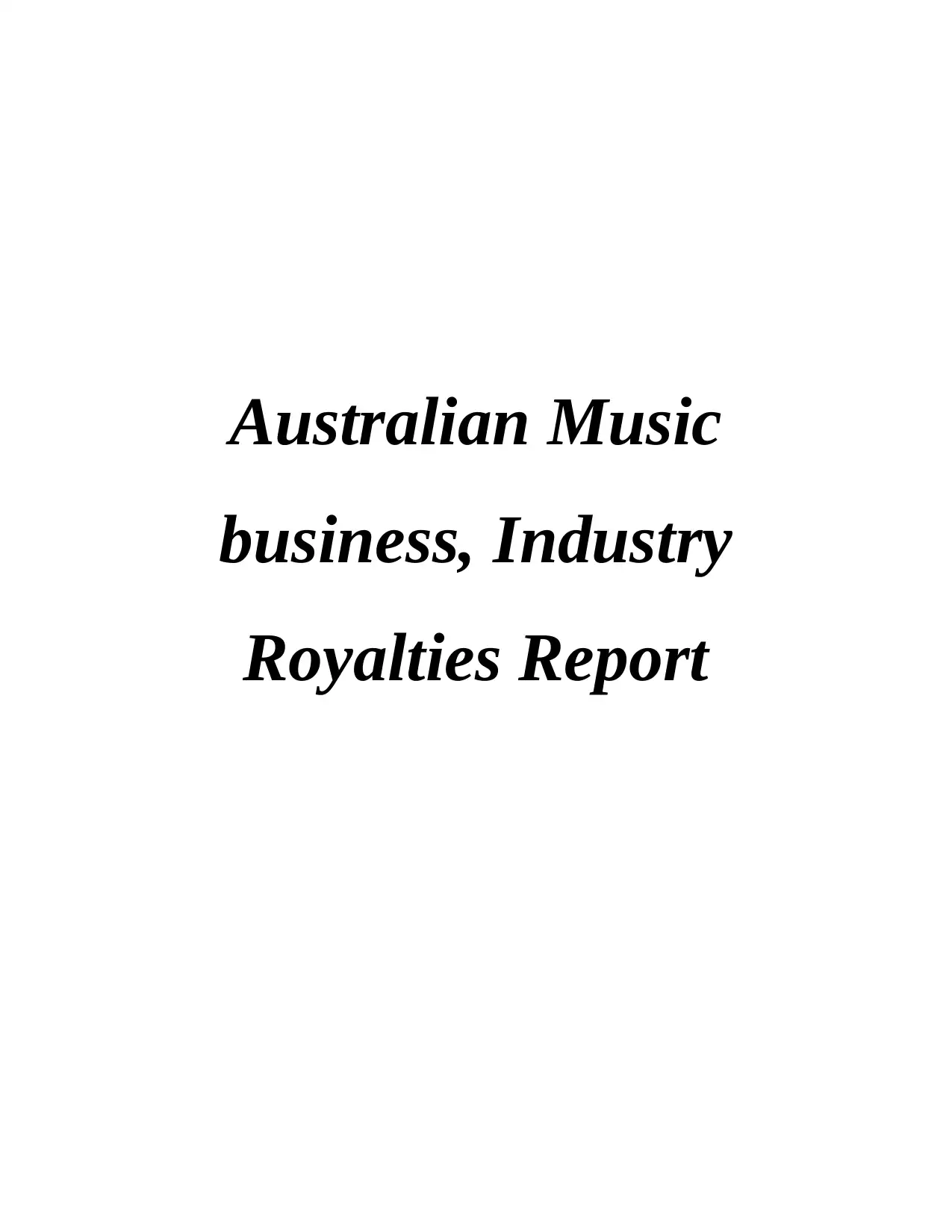
Australian Music
business, Industry
Royalties Report
business, Industry
Royalties Report
Paraphrase This Document
Need a fresh take? Get an instant paraphrase of this document with our AI Paraphraser
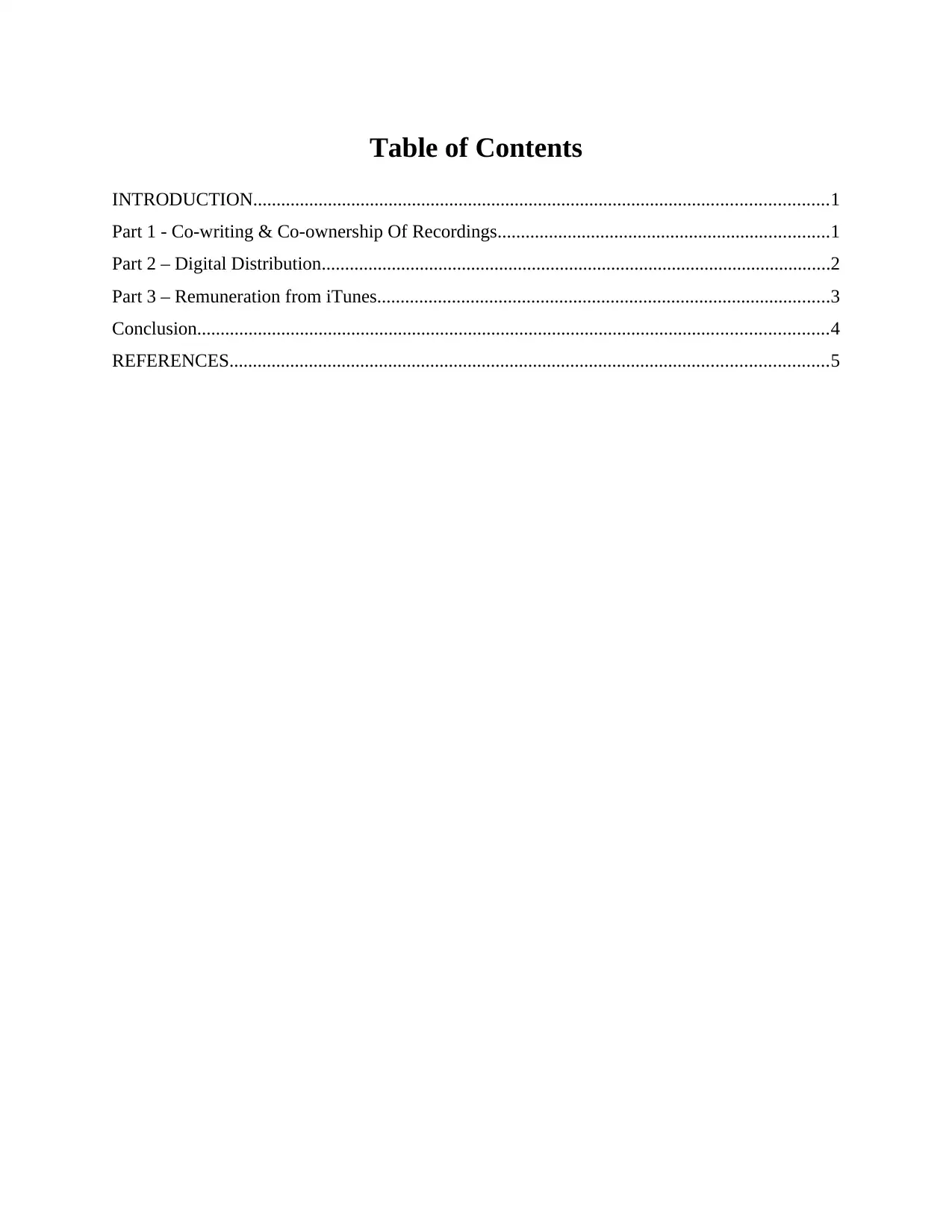
Table of Contents
INTRODUCTION...........................................................................................................................1
Part 1 - Co-writing & Co-ownership Of Recordings.......................................................................1
Part 2 – Digital Distribution.............................................................................................................2
Part 3 – Remuneration from iTunes.................................................................................................3
Conclusion.......................................................................................................................................4
REFERENCES................................................................................................................................5
INTRODUCTION...........................................................................................................................1
Part 1 - Co-writing & Co-ownership Of Recordings.......................................................................1
Part 2 – Digital Distribution.............................................................................................................2
Part 3 – Remuneration from iTunes.................................................................................................3
Conclusion.......................................................................................................................................4
REFERENCES................................................................................................................................5
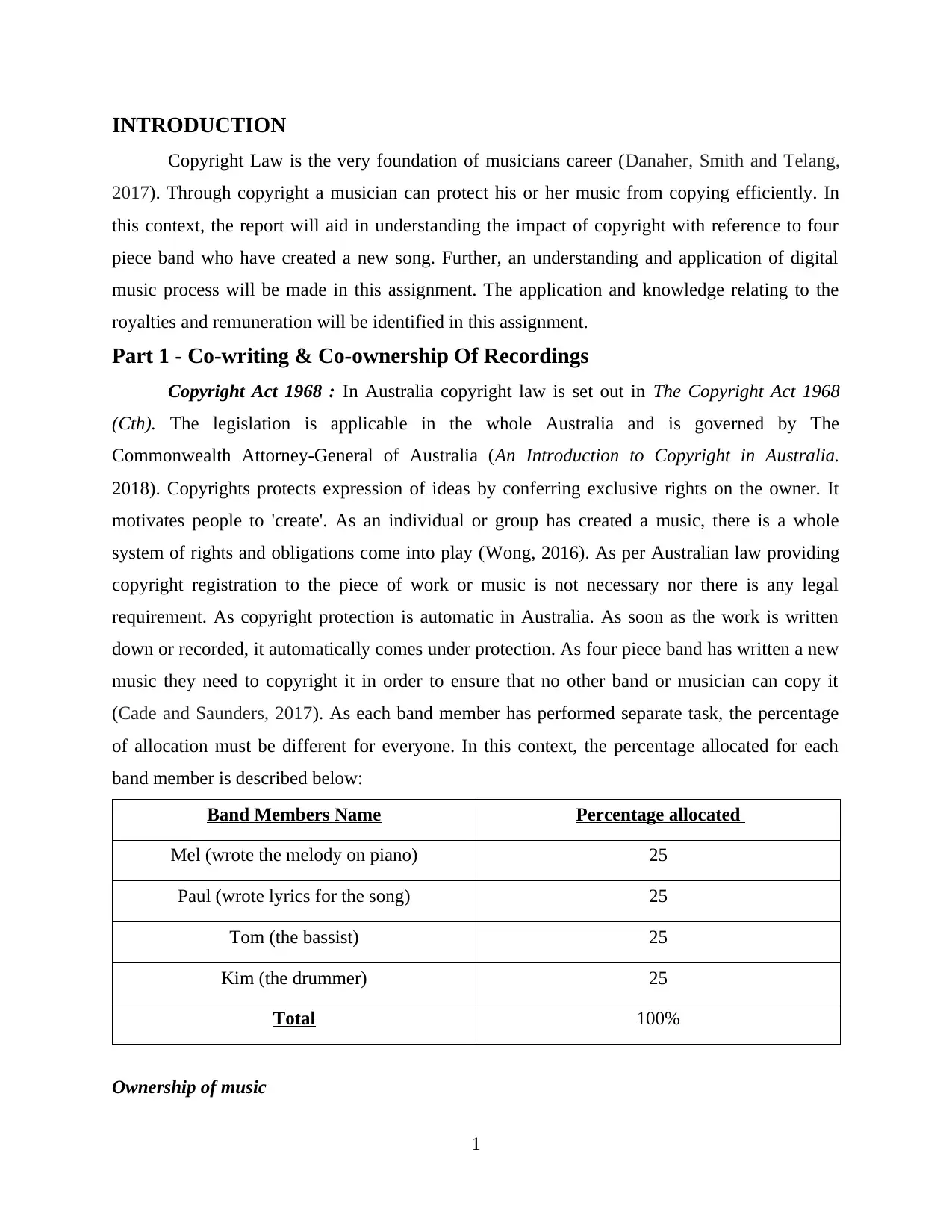
INTRODUCTION
Copyright Law is the very foundation of musicians career (Danaher, Smith and Telang,
2017). Through copyright a musician can protect his or her music from copying efficiently. In
this context, the report will aid in understanding the impact of copyright with reference to four
piece band who have created a new song. Further, an understanding and application of digital
music process will be made in this assignment. The application and knowledge relating to the
royalties and remuneration will be identified in this assignment.
Part 1 - Co-writing & Co-ownership Of Recordings
Copyright Act 1968 : In Australia copyright law is set out in The Copyright Act 1968
(Cth). The legislation is applicable in the whole Australia and is governed by The
Commonwealth Attorney-General of Australia (An Introduction to Copyright in Australia.
2018). Copyrights protects expression of ideas by conferring exclusive rights on the owner. It
motivates people to 'create'. As an individual or group has created a music, there is a whole
system of rights and obligations come into play (Wong, 2016). As per Australian law providing
copyright registration to the piece of work or music is not necessary nor there is any legal
requirement. As copyright protection is automatic in Australia. As soon as the work is written
down or recorded, it automatically comes under protection. As four piece band has written a new
music they need to copyright it in order to ensure that no other band or musician can copy it
(Cade and Saunders, 2017). As each band member has performed separate task, the percentage
of allocation must be different for everyone. In this context, the percentage allocated for each
band member is described below:
Band Members Name Percentage allocated
Mel (wrote the melody on piano) 25
Paul (wrote lyrics for the song) 25
Tom (the bassist) 25
Kim (the drummer) 25
Total 100%
Ownership of music
1
Copyright Law is the very foundation of musicians career (Danaher, Smith and Telang,
2017). Through copyright a musician can protect his or her music from copying efficiently. In
this context, the report will aid in understanding the impact of copyright with reference to four
piece band who have created a new song. Further, an understanding and application of digital
music process will be made in this assignment. The application and knowledge relating to the
royalties and remuneration will be identified in this assignment.
Part 1 - Co-writing & Co-ownership Of Recordings
Copyright Act 1968 : In Australia copyright law is set out in The Copyright Act 1968
(Cth). The legislation is applicable in the whole Australia and is governed by The
Commonwealth Attorney-General of Australia (An Introduction to Copyright in Australia.
2018). Copyrights protects expression of ideas by conferring exclusive rights on the owner. It
motivates people to 'create'. As an individual or group has created a music, there is a whole
system of rights and obligations come into play (Wong, 2016). As per Australian law providing
copyright registration to the piece of work or music is not necessary nor there is any legal
requirement. As copyright protection is automatic in Australia. As soon as the work is written
down or recorded, it automatically comes under protection. As four piece band has written a new
music they need to copyright it in order to ensure that no other band or musician can copy it
(Cade and Saunders, 2017). As each band member has performed separate task, the percentage
of allocation must be different for everyone. In this context, the percentage allocated for each
band member is described below:
Band Members Name Percentage allocated
Mel (wrote the melody on piano) 25
Paul (wrote lyrics for the song) 25
Tom (the bassist) 25
Kim (the drummer) 25
Total 100%
Ownership of music
1
⊘ This is a preview!⊘
Do you want full access?
Subscribe today to unlock all pages.

Trusted by 1+ million students worldwide
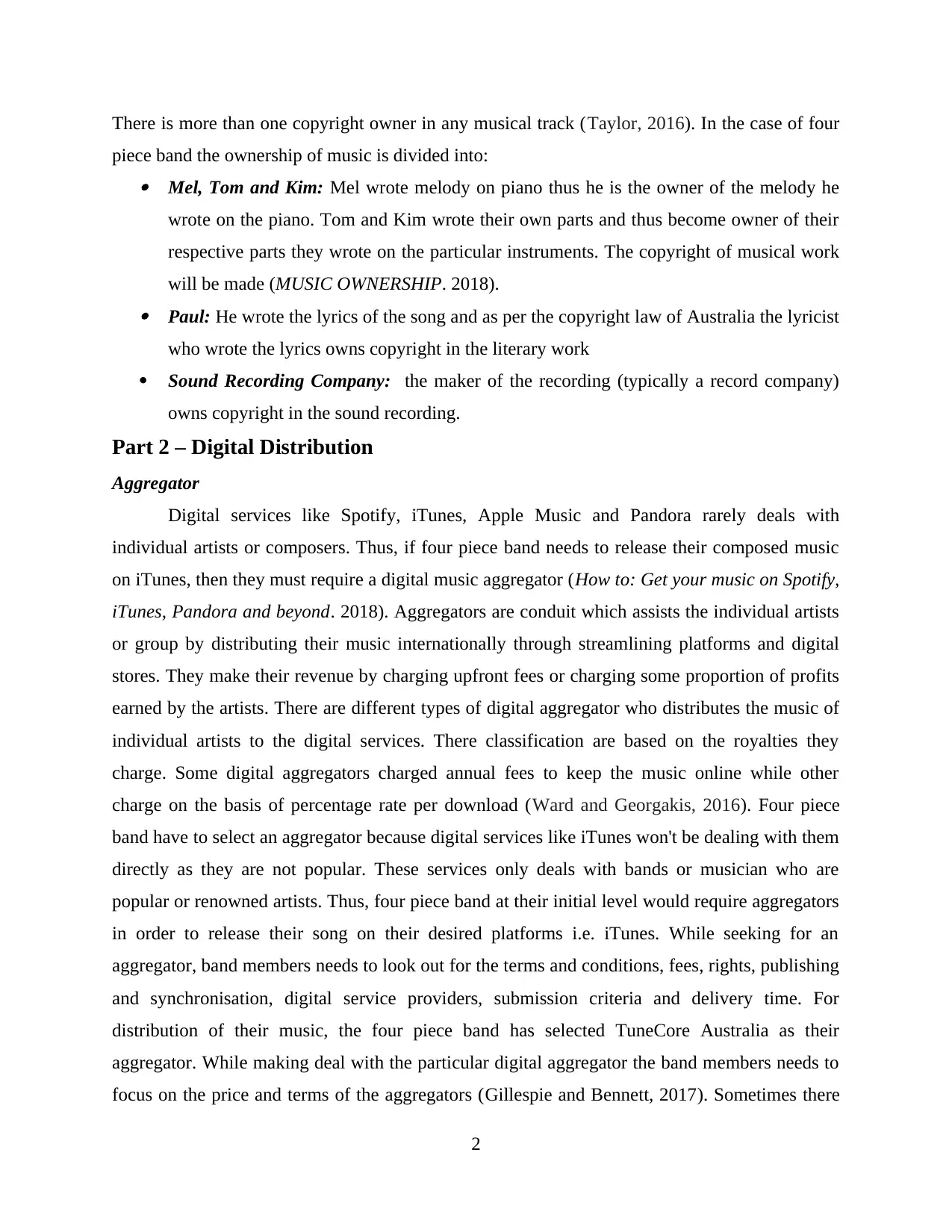
There is more than one copyright owner in any musical track (Taylor, 2016). In the case of four
piece band the ownership of music is divided into: Mel, Tom and Kim: Mel wrote melody on piano thus he is the owner of the melody he
wrote on the piano. Tom and Kim wrote their own parts and thus become owner of their
respective parts they wrote on the particular instruments. The copyright of musical work
will be made (MUSIC OWNERSHIP. 2018). Paul: He wrote the lyrics of the song and as per the copyright law of Australia the lyricist
who wrote the lyrics owns copyright in the literary work
Sound Recording Company: the maker of the recording (typically a record company)
owns copyright in the sound recording.
Part 2 – Digital Distribution
Aggregator
Digital services like Spotify, iTunes, Apple Music and Pandora rarely deals with
individual artists or composers. Thus, if four piece band needs to release their composed music
on iTunes, then they must require a digital music aggregator (How to: Get your music on Spotify,
iTunes, Pandora and beyond. 2018). Aggregators are conduit which assists the individual artists
or group by distributing their music internationally through streamlining platforms and digital
stores. They make their revenue by charging upfront fees or charging some proportion of profits
earned by the artists. There are different types of digital aggregator who distributes the music of
individual artists to the digital services. There classification are based on the royalties they
charge. Some digital aggregators charged annual fees to keep the music online while other
charge on the basis of percentage rate per download (Ward and Georgakis, 2016). Four piece
band have to select an aggregator because digital services like iTunes won't be dealing with them
directly as they are not popular. These services only deals with bands or musician who are
popular or renowned artists. Thus, four piece band at their initial level would require aggregators
in order to release their song on their desired platforms i.e. iTunes. While seeking for an
aggregator, band members needs to look out for the terms and conditions, fees, rights, publishing
and synchronisation, digital service providers, submission criteria and delivery time. For
distribution of their music, the four piece band has selected TuneCore Australia as their
aggregator. While making deal with the particular digital aggregator the band members needs to
focus on the price and terms of the aggregators (Gillespie and Bennett, 2017). Sometimes there
2
piece band the ownership of music is divided into: Mel, Tom and Kim: Mel wrote melody on piano thus he is the owner of the melody he
wrote on the piano. Tom and Kim wrote their own parts and thus become owner of their
respective parts they wrote on the particular instruments. The copyright of musical work
will be made (MUSIC OWNERSHIP. 2018). Paul: He wrote the lyrics of the song and as per the copyright law of Australia the lyricist
who wrote the lyrics owns copyright in the literary work
Sound Recording Company: the maker of the recording (typically a record company)
owns copyright in the sound recording.
Part 2 – Digital Distribution
Aggregator
Digital services like Spotify, iTunes, Apple Music and Pandora rarely deals with
individual artists or composers. Thus, if four piece band needs to release their composed music
on iTunes, then they must require a digital music aggregator (How to: Get your music on Spotify,
iTunes, Pandora and beyond. 2018). Aggregators are conduit which assists the individual artists
or group by distributing their music internationally through streamlining platforms and digital
stores. They make their revenue by charging upfront fees or charging some proportion of profits
earned by the artists. There are different types of digital aggregator who distributes the music of
individual artists to the digital services. There classification are based on the royalties they
charge. Some digital aggregators charged annual fees to keep the music online while other
charge on the basis of percentage rate per download (Ward and Georgakis, 2016). Four piece
band have to select an aggregator because digital services like iTunes won't be dealing with them
directly as they are not popular. These services only deals with bands or musician who are
popular or renowned artists. Thus, four piece band at their initial level would require aggregators
in order to release their song on their desired platforms i.e. iTunes. While seeking for an
aggregator, band members needs to look out for the terms and conditions, fees, rights, publishing
and synchronisation, digital service providers, submission criteria and delivery time. For
distribution of their music, the four piece band has selected TuneCore Australia as their
aggregator. While making deal with the particular digital aggregator the band members needs to
focus on the price and terms of the aggregators (Gillespie and Bennett, 2017). Sometimes there
2
Paraphrase This Document
Need a fresh take? Get an instant paraphrase of this document with our AI Paraphraser
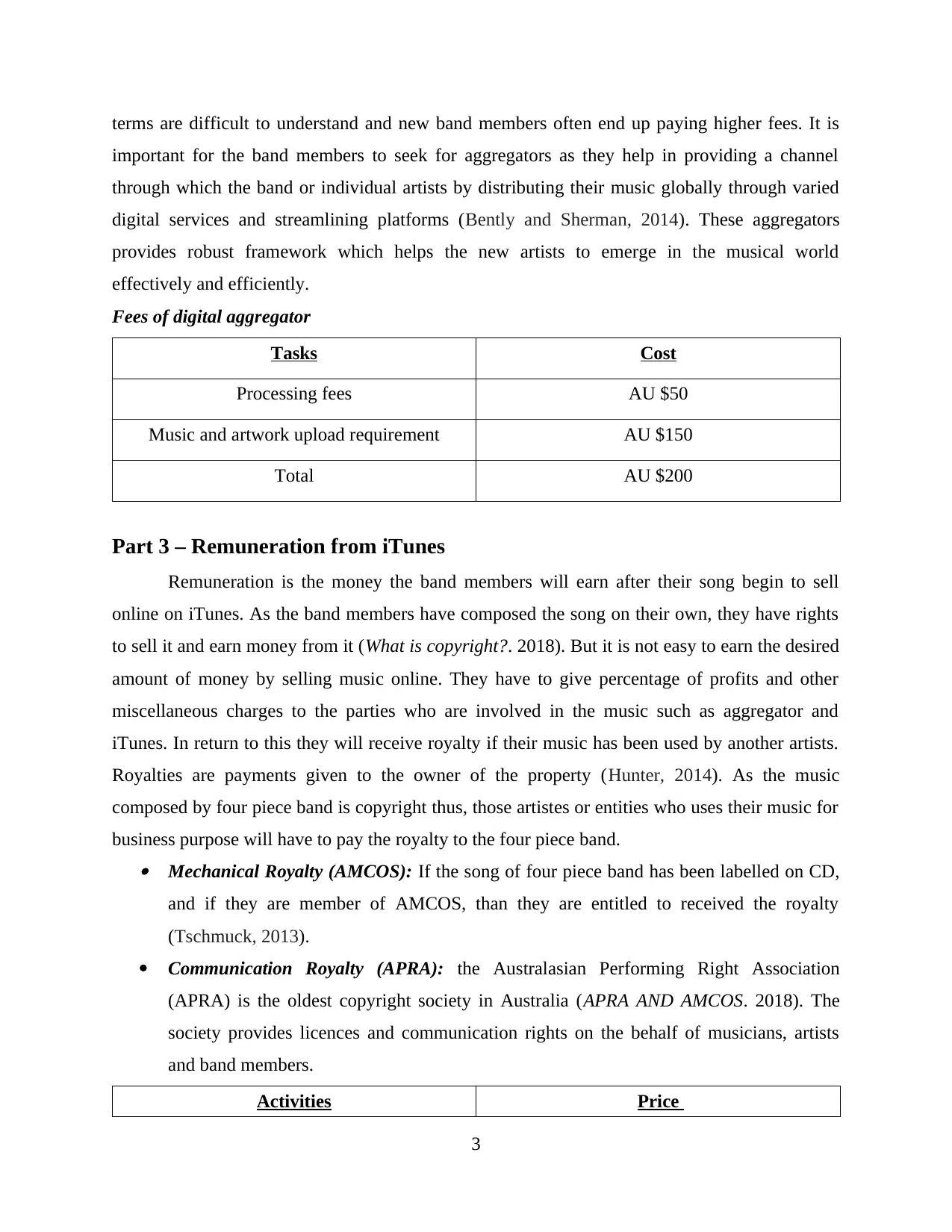
terms are difficult to understand and new band members often end up paying higher fees. It is
important for the band members to seek for aggregators as they help in providing a channel
through which the band or individual artists by distributing their music globally through varied
digital services and streamlining platforms (Bently and Sherman, 2014). These aggregators
provides robust framework which helps the new artists to emerge in the musical world
effectively and efficiently.
Fees of digital aggregator
Tasks Cost
Processing fees AU $50
Music and artwork upload requirement AU $150
Total AU $200
Part 3 – Remuneration from iTunes
Remuneration is the money the band members will earn after their song begin to sell
online on iTunes. As the band members have composed the song on their own, they have rights
to sell it and earn money from it (What is copyright?. 2018). But it is not easy to earn the desired
amount of money by selling music online. They have to give percentage of profits and other
miscellaneous charges to the parties who are involved in the music such as aggregator and
iTunes. In return to this they will receive royalty if their music has been used by another artists.
Royalties are payments given to the owner of the property (Hunter, 2014). As the music
composed by four piece band is copyright thus, those artistes or entities who uses their music for
business purpose will have to pay the royalty to the four piece band. Mechanical Royalty (AMCOS): If the song of four piece band has been labelled on CD,
and if they are member of AMCOS, than they are entitled to received the royalty
(Tschmuck, 2013).
Communication Royalty (APRA): the Australasian Performing Right Association
(APRA) is the oldest copyright society in Australia (APRA AND AMCOS. 2018). The
society provides licences and communication rights on the behalf of musicians, artists
and band members.
Activities Price
3
important for the band members to seek for aggregators as they help in providing a channel
through which the band or individual artists by distributing their music globally through varied
digital services and streamlining platforms (Bently and Sherman, 2014). These aggregators
provides robust framework which helps the new artists to emerge in the musical world
effectively and efficiently.
Fees of digital aggregator
Tasks Cost
Processing fees AU $50
Music and artwork upload requirement AU $150
Total AU $200
Part 3 – Remuneration from iTunes
Remuneration is the money the band members will earn after their song begin to sell
online on iTunes. As the band members have composed the song on their own, they have rights
to sell it and earn money from it (What is copyright?. 2018). But it is not easy to earn the desired
amount of money by selling music online. They have to give percentage of profits and other
miscellaneous charges to the parties who are involved in the music such as aggregator and
iTunes. In return to this they will receive royalty if their music has been used by another artists.
Royalties are payments given to the owner of the property (Hunter, 2014). As the music
composed by four piece band is copyright thus, those artistes or entities who uses their music for
business purpose will have to pay the royalty to the four piece band. Mechanical Royalty (AMCOS): If the song of four piece band has been labelled on CD,
and if they are member of AMCOS, than they are entitled to received the royalty
(Tschmuck, 2013).
Communication Royalty (APRA): the Australasian Performing Right Association
(APRA) is the oldest copyright society in Australia (APRA AND AMCOS. 2018). The
society provides licences and communication rights on the behalf of musicians, artists
and band members.
Activities Price
3
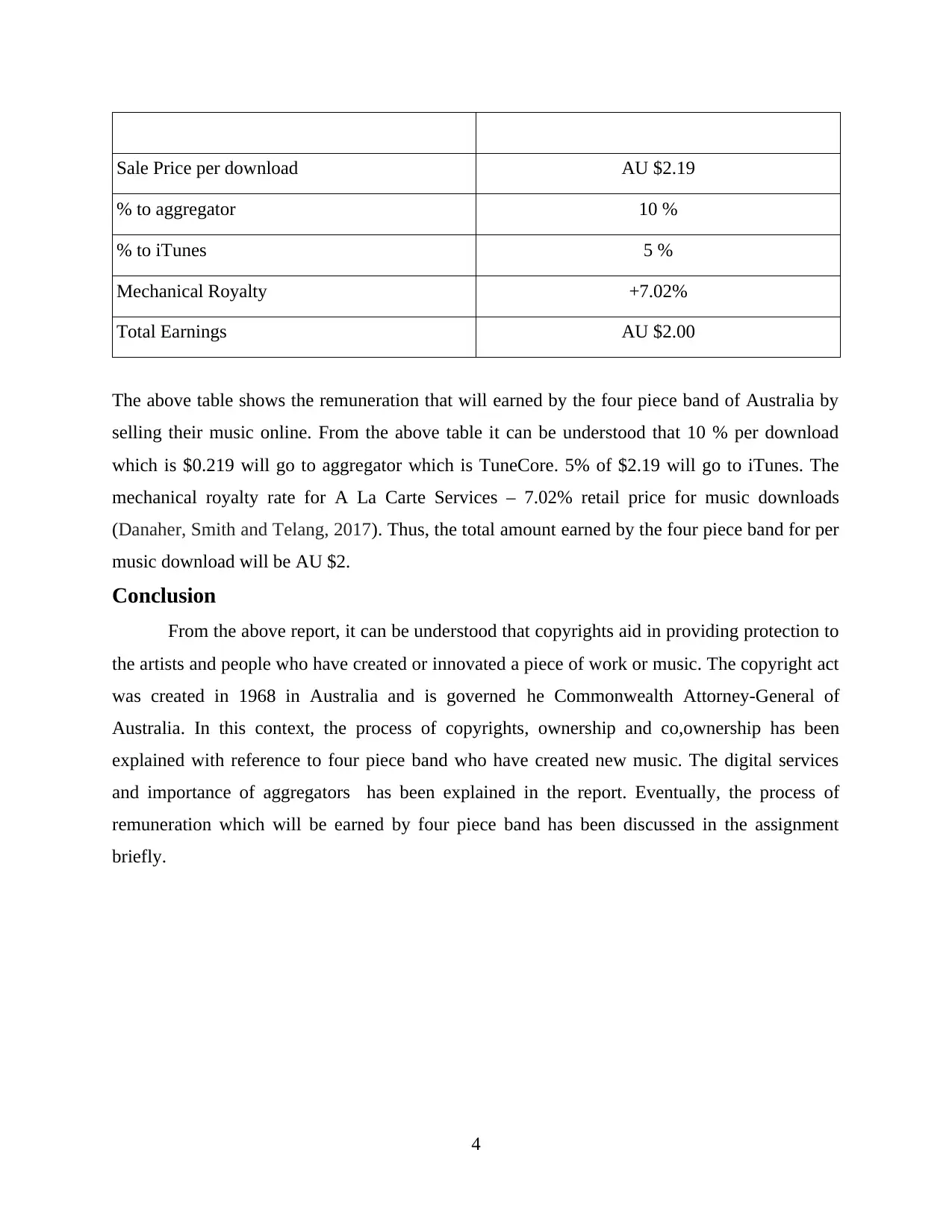
Sale Price per download AU $2.19
% to aggregator 10 %
% to iTunes 5 %
Mechanical Royalty +7.02%
Total Earnings AU $2.00
The above table shows the remuneration that will earned by the four piece band of Australia by
selling their music online. From the above table it can be understood that 10 % per download
which is $0.219 will go to aggregator which is TuneCore. 5% of $2.19 will go to iTunes. The
mechanical royalty rate for A La Carte Services – 7.02% retail price for music downloads
(Danaher, Smith and Telang, 2017). Thus, the total amount earned by the four piece band for per
music download will be AU $2.
Conclusion
From the above report, it can be understood that copyrights aid in providing protection to
the artists and people who have created or innovated a piece of work or music. The copyright act
was created in 1968 in Australia and is governed he Commonwealth Attorney-General of
Australia. In this context, the process of copyrights, ownership and co,ownership has been
explained with reference to four piece band who have created new music. The digital services
and importance of aggregators has been explained in the report. Eventually, the process of
remuneration which will be earned by four piece band has been discussed in the assignment
briefly.
4
% to aggregator 10 %
% to iTunes 5 %
Mechanical Royalty +7.02%
Total Earnings AU $2.00
The above table shows the remuneration that will earned by the four piece band of Australia by
selling their music online. From the above table it can be understood that 10 % per download
which is $0.219 will go to aggregator which is TuneCore. 5% of $2.19 will go to iTunes. The
mechanical royalty rate for A La Carte Services – 7.02% retail price for music downloads
(Danaher, Smith and Telang, 2017). Thus, the total amount earned by the four piece band for per
music download will be AU $2.
Conclusion
From the above report, it can be understood that copyrights aid in providing protection to
the artists and people who have created or innovated a piece of work or music. The copyright act
was created in 1968 in Australia and is governed he Commonwealth Attorney-General of
Australia. In this context, the process of copyrights, ownership and co,ownership has been
explained with reference to four piece band who have created new music. The digital services
and importance of aggregators has been explained in the report. Eventually, the process of
remuneration which will be earned by four piece band has been discussed in the assignment
briefly.
4
⊘ This is a preview!⊘
Do you want full access?
Subscribe today to unlock all pages.

Trusted by 1+ million students worldwide
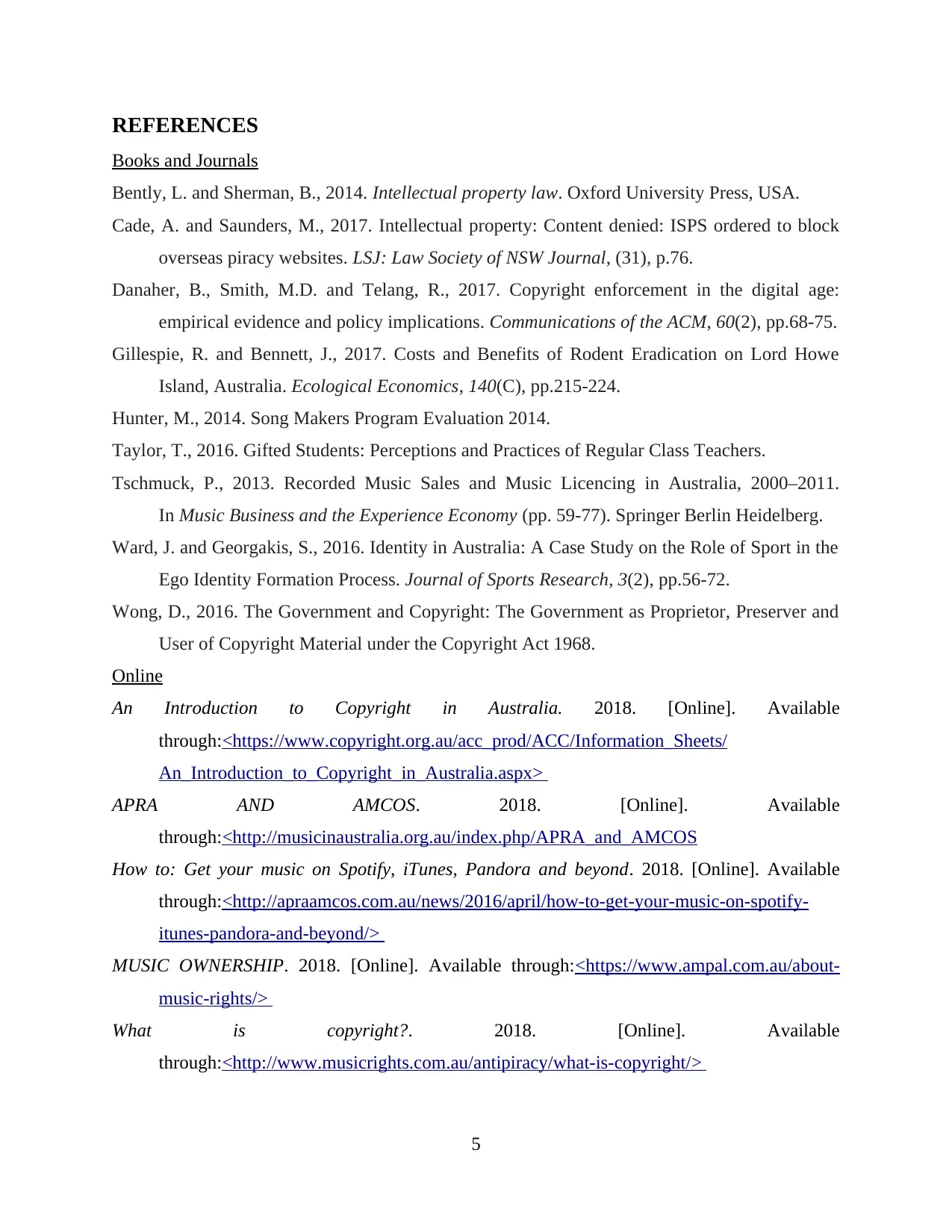
REFERENCES
Books and Journals
Bently, L. and Sherman, B., 2014. Intellectual property law. Oxford University Press, USA.
Cade, A. and Saunders, M., 2017. Intellectual property: Content denied: ISPS ordered to block
overseas piracy websites. LSJ: Law Society of NSW Journal, (31), p.76.
Danaher, B., Smith, M.D. and Telang, R., 2017. Copyright enforcement in the digital age:
empirical evidence and policy implications. Communications of the ACM, 60(2), pp.68-75.
Gillespie, R. and Bennett, J., 2017. Costs and Benefits of Rodent Eradication on Lord Howe
Island, Australia. Ecological Economics, 140(C), pp.215-224.
Hunter, M., 2014. Song Makers Program Evaluation 2014.
Taylor, T., 2016. Gifted Students: Perceptions and Practices of Regular Class Teachers.
Tschmuck, P., 2013. Recorded Music Sales and Music Licencing in Australia, 2000–2011.
In Music Business and the Experience Economy (pp. 59-77). Springer Berlin Heidelberg.
Ward, J. and Georgakis, S., 2016. Identity in Australia: A Case Study on the Role of Sport in the
Ego Identity Formation Process. Journal of Sports Research, 3(2), pp.56-72.
Wong, D., 2016. The Government and Copyright: The Government as Proprietor, Preserver and
User of Copyright Material under the Copyright Act 1968.
Online
An Introduction to Copyright in Australia. 2018. [Online]. Available
through:<https://www.copyright.org.au/acc_prod/ACC/Information_Sheets/
An_Introduction_to_Copyright_in_Australia.aspx>
APRA AND AMCOS. 2018. [Online]. Available
through:<http://musicinaustralia.org.au/index.php/APRA_and_AMCOS
How to: Get your music on Spotify, iTunes, Pandora and beyond. 2018. [Online]. Available
through:<http://apraamcos.com.au/news/2016/april/how-to-get-your-music-on-spotify-
itunes-pandora-and-beyond/>
MUSIC OWNERSHIP. 2018. [Online]. Available through:<https://www.ampal.com.au/about-
music-rights/>
What is copyright?. 2018. [Online]. Available
through:<http://www.musicrights.com.au/antipiracy/what-is-copyright/>
5
Books and Journals
Bently, L. and Sherman, B., 2014. Intellectual property law. Oxford University Press, USA.
Cade, A. and Saunders, M., 2017. Intellectual property: Content denied: ISPS ordered to block
overseas piracy websites. LSJ: Law Society of NSW Journal, (31), p.76.
Danaher, B., Smith, M.D. and Telang, R., 2017. Copyright enforcement in the digital age:
empirical evidence and policy implications. Communications of the ACM, 60(2), pp.68-75.
Gillespie, R. and Bennett, J., 2017. Costs and Benefits of Rodent Eradication on Lord Howe
Island, Australia. Ecological Economics, 140(C), pp.215-224.
Hunter, M., 2014. Song Makers Program Evaluation 2014.
Taylor, T., 2016. Gifted Students: Perceptions and Practices of Regular Class Teachers.
Tschmuck, P., 2013. Recorded Music Sales and Music Licencing in Australia, 2000–2011.
In Music Business and the Experience Economy (pp. 59-77). Springer Berlin Heidelberg.
Ward, J. and Georgakis, S., 2016. Identity in Australia: A Case Study on the Role of Sport in the
Ego Identity Formation Process. Journal of Sports Research, 3(2), pp.56-72.
Wong, D., 2016. The Government and Copyright: The Government as Proprietor, Preserver and
User of Copyright Material under the Copyright Act 1968.
Online
An Introduction to Copyright in Australia. 2018. [Online]. Available
through:<https://www.copyright.org.au/acc_prod/ACC/Information_Sheets/
An_Introduction_to_Copyright_in_Australia.aspx>
APRA AND AMCOS. 2018. [Online]. Available
through:<http://musicinaustralia.org.au/index.php/APRA_and_AMCOS
How to: Get your music on Spotify, iTunes, Pandora and beyond. 2018. [Online]. Available
through:<http://apraamcos.com.au/news/2016/april/how-to-get-your-music-on-spotify-
itunes-pandora-and-beyond/>
MUSIC OWNERSHIP. 2018. [Online]. Available through:<https://www.ampal.com.au/about-
music-rights/>
What is copyright?. 2018. [Online]. Available
through:<http://www.musicrights.com.au/antipiracy/what-is-copyright/>
5
Paraphrase This Document
Need a fresh take? Get an instant paraphrase of this document with our AI Paraphraser

6
1 out of 8
Your All-in-One AI-Powered Toolkit for Academic Success.
+13062052269
info@desklib.com
Available 24*7 on WhatsApp / Email
![[object Object]](/_next/static/media/star-bottom.7253800d.svg)
Unlock your academic potential
Copyright © 2020–2025 A2Z Services. All Rights Reserved. Developed and managed by ZUCOL.
